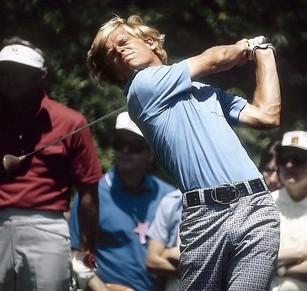
Get ready for the biggest swings on the leaderboards of all the majors: the U.S. Open.
Wait ... what? Could this be true? Isn't the U.S. Open about grinding out pars on near-dead greens in which holding on to you sanity it the greatest test? That may be the reputation but the numbers in recent years suggest the U.S. Open can be a wild ride.
This idea goes against the conventional wisdom that the U.S. Open is the biggest brute of the majors in which the course is set up for the most defensive golf in all tournament golf. This may be true but even that situation can lead to a bigger varia
nce in the results once the tournament is under way. We looked into the numbers.
It's been forty years since Johnny Miller shot that final round 63 at Oakmont to win the U.S. Open despite starting Sunday in 13th place and six strokes back. Maybe that angered the USGA and it took over another decade for a player outside of first or second place after the third round to win the U.S. Open again (Larry Nelson from 3rd place in 1983 and he was actually only one stroke back to start the final round). This was in contrast to the other three major championships in which someone outside of first or second place won 10 times between Miller's U.S. Open in 1973 and Nelson's in 1983.

THE OTHER MAJORS AND REPUTATION
The Masters is said to start on the back nine on Sunday. The Open Championship is thought to be subject to the harsh and tempermental weather of the region on courses that, in turn, can be left defenseless on mild days. The PGA Championship winds down the season and feels like it introduces upsets and potential new stars to the stage. As noted above, the U.S. Open has the reputation of brutal courses, near-dead greens and the need to grind out par after par.
The numbers suggest these reputations may no longer be based in reality.
A look at the champions over the past 40 years shows that the U.S. Open is the major in which is it most likely someone outside the last group will win. It is also more likely that a player that is not in the last two groups (i.e. outside of 4th place going into Sunday) will win the championship.
The numbers showing the ability a player to come from the field to win the U.S. Open have likely improved because of the leadership of now Executive Director Mike Davis. It was Davis in 2005 that took leadership of the USGA competition committee to introduce graduated rough and created some birdie opportunities for players via the setup on the weekend. It cannot be a coincidence that in the 6 consecutive years prior to Davis and 2005, the leader after round 3 won the U.S. Open. In the eight championships contested since 2005, the round 3 leader has only won twice. Once was Tiger in 2008 and no one could complain about the excitement of that incredible championship. The other time was Rory McIlroy's dominating performance in 2011.
In making the analysis, we looked at three time periods:
- The past 40 years in total (i.e. since Miller's win at Oakmont)
- The 20 years before 1997 (the "Pre-Tiger Era")
- From 1997 to present (the "Tiger Era")
- The last 10 majors contested for each major ("the Last 10")
First, consider for each of these categories the number of times and percentages the leader or player in second place at the start of the 4th round won the event.

If anything, this chart suggests the U.S. Open more than any of the other majors provides an opportunity for a player to come out of the pack to win. In other words, the player is less likely to be in the final group than the Masters and the PGA Championship.
Consider a similar analysis but, instead of where the player is positioned in the field, consider the number of times a player more than 2 strokes off the lead wins the particular major championship.

This chart would also suggest that there have been greater swings in the lead in the U.S. Open than the other Majors. If anything, the numbers are actually muted for the "Tiger Era" because those years include Tiger's and Rory's dominating performances in 2000 and 2011 respectively. Remove those two events and in the U.S. Open since 1997, someone more than 2 strokes off the lead on Sunday morning wins the championship 50% of the time!
In other words, despite the reputations of each event, recently, the U.S. Open is more likely to provide a wild finish compared to the Masters. In fact recently, the Masters winner is almost always from the last group and it is very rare for a player to come back from more than 2 strokes at the start of Sunday to claim the green jacket.
The numbers also show that perhaps the PGA Championship is moving the wrong direction in terms of excitement. Prior to Tiger, the PGA typically showed more variance between the standing at the end of the 3rd rounds and the eventual champion. Since Tiger has arrived on the scene, the PGA Championship has shown the least variance.
Granted, lead changes and come-from-behind performances do not necessarily equate to excitement. No one would deny how exciting the past several Masters have been. However, it is easy to forget that prior to several years ago, it was getting a bit predictable. One could argue the Masters finally got its act together in terms of course setup after a 19 year period between 91 and 09 in which the winner was the 3rd round leader a mind-numbing 14 of those years or 75% of the time. For two decades, the tournament was not decided on the back nine on Sunday but typically on Saturday.
In contrast, the numbers shot that the U.S. Open compared to the other major championships has variety and the ability of players to come from behind. The trend also shows the USGA continues to move in the right direction.
In addition to Philly cheesesteaks, it's just another reason to be excited about the U.S. Open.
Douglas Han
